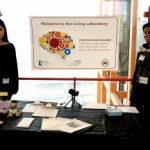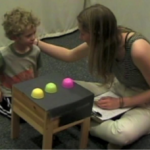The Allbritton Center for the Study of Public life supports engaged scholarship on and off the Wesleyan campus. We define “Engaged Scholarship” as partnerships of university knowledge and resources with those of the public and private sectors to enrich scholarship, research, creative activity, and public knowledge; enhance curriculum, teaching and learning; prepare educated, engaged citizens; strengthen democratic values and civic responsibility; address and help solve critical social problems; and contribute to the public. A compendium of engaged scholarship and service by Wesleyan faculty may be found here.
 Hilary Barth is an Associate Professor of Psychology at Wesleyan. In 2013, the Cognitive Development Lab, which she co-directs with Professor Anna Shusterman, initiated the “Living Laboratory,” a partnership with the Connecticut Science Center in Hartford. Living Laboratories exist nationwide as collaborations between science and children’s museums and universities. Professor Barth’s lab coordinates one of only two Living Laboratories in the country that is run by a primarily undergraduate institution.
Hilary Barth is an Associate Professor of Psychology at Wesleyan. In 2013, the Cognitive Development Lab, which she co-directs with Professor Anna Shusterman, initiated the “Living Laboratory,” a partnership with the Connecticut Science Center in Hartford. Living Laboratories exist nationwide as collaborations between science and children’s museums and universities. Professor Barth’s lab coordinates one of only two Living Laboratories in the country that is run by a primarily undergraduate institution.
Through this partnership, undergraduate research assistance and research staff visit the Connecticut Science Center to collect data for their ongoing studies. They also lead interactive demonstrations of recent work in cognitive and developmental science for visiting families. Students bring areas of science that are not often included in museums to the public, and offer children an opportunity to talk to practicing scientists from historically underrepresented groups. In turn, the students practice communicating scientific concepts using museum-style education methods.



These presentations, especially those related to childhood development, are of particular interest to parents visiting the museum with their children. This is a unique opportunity for parents to get involved in the museum themselves.
Undergraduate students actively participate in research with guests at the science center. Below is an excerpt from their report “National Living Laboratory 2014-15 Cohort Stipend Final Report: The Connecticut Science Center & the Cognitive Development Labs at Wesleyan University.“
In “The Choices Game,” CDL researchers are interested in how the presentation of options affects children’s choices. We displayed foam beads of four different colors in three bowls: Two bowls each held one color, and the third bowl contained two different colors. Children were then asked to choose five beads to make a necklace. So far, we’ve found that children tend to take more beads from the two bowls that contain one color than they do from the bowl with two colors. This means that presenting the beads in this way makes children see three categories (the number of bowls) instead of four (the number of colors), and the way in which options are presented does affect their choices. This study sparks a lot of interesting conversations with parents about methodological issues such as probabilities, preference effects, and counterbalancing.


